Canon PowerShot S1-IS: First Impressions
For the past two years or so, I’ve had the Canon Powershot S30, a 3.2-megapixel camera which still today is regarded as one of the best digital cameras out there (though now it’s the S45, it’s still essentially the same camera). What I’ve always missed, however, was zoom–the S30 and its immediate kin only do the standard 3x zoom, which really isn’t much. Other features–such as better movies, for example–were on my list, but the zoom, on a good camera, was my top want. For some time, I;ve had my eye on the Canon PowerShot S1-IS.
I looked around at various cameras, and almost at one point switched to the Olympus C-770 Ultra Zoom, slightly more expensive and slightly better-rated than the S1; I also trust Olympus’ cameras (I had a nice one, until a former girlfriend stole it from me–an $800 camera at the time of purchase, too!), and the C-770 has 4 megapixels to the S1’s 3.2, and has better macro features, as far as I can tell. However, the Olympus only takes xD memory cards, and I have grown to respect the Compact Flash type of flash memory card–they are cheapest and have the biggest capacities (the SanDisk Ultra CF card has a transfer speed about twice the xD’s, and the 1 GB Compact Flash card is actually cheaper than the largest xD card, half the size at 512 MB). I also didn’t much care for the Olympus’ interface. So in the end, I went with the Canon.
I’ve only been using it for a bit over a day now, and in general I am very pleased with it. First of all, the zoom performs as advertised, giving me the extra reach I’ve wanted for a long time. Canon enhanced the zoom with very effective image stabilization (the “IS” in the camera name), and that helps to get sharper images not only in long zoom shots, but also regular low-light shots. With a regular camera, it took careful holding and several tries to get a sharp image at 1/30th of a second or less, but the new camera makes that a lot easier. It does feel a bit funny not to have the image displayed on the LCD exactly match your hand movements, but that’s a very small thing to get over.
Very soon I’ll be comparing shots with the 10x zoom versus my dad’s S40’s 3x zoom, but for now, here is a little example of just the 10x zoom. First, a reduced image of the entire shot I took of pigeons on a power pole and line, taken from across a supermarket parking lot:
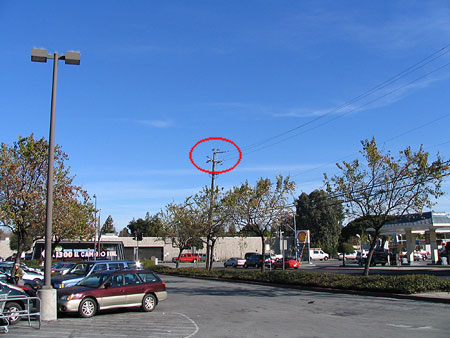
The birds are circled at the center. Now, the same shot, at full size, cropped to show the birds at the center:
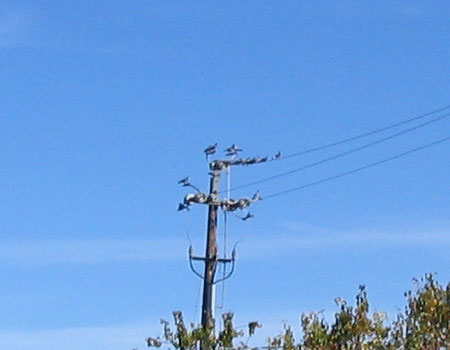
And finally, a shot taken at 10x zoom, also full-size and cropped:
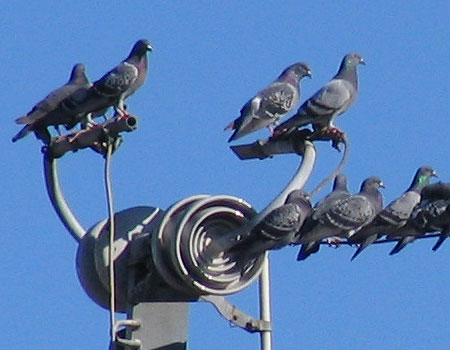
That’s not a bad zoom! I also found a black squirrel in a tree, and managed to get a shot of that with the zoom; for this display image, I had to scale it down by half in addition to cropping:

I still have a lot more experimentation to do, but as you can see, the zoom seems to be doing great so far. Canon’s zoom is also very fast and very quiet; I can go to full 10x zoom much faster than I can go to full 3x zoom on my old camera. In fact, most first-time handlers of the camera see the zoom as too fast–hard to get an intermediate zoom because it just zips to the extremes; but with a little practice, you’ll notice that an incremental touch on the zoom toggle allows for a slower zoom and perfect control. The zoom is also very quiet, and so can be used while shooting video.
I was a bit worried for a while that this camera had no macro mode. There is no flower-icon macro setting button, and macro focus is not mentioned in the manual at all. But it can take pretty good macro shots without switching settings; just be sure to have the camera fully zoomed out. And while it is advertised as having a minimal focus range of 3.9 inches, I found that I could focus on objects closer than 2 inches from the lens. Here is one photo of a small flower, maybe just less than an inch across, full-size but cropped:

With my S30, I wanted to take photos of stuck pixels on my Powerbook so as to show them to my students in the Computer class I teach, but with that camera, even in macro mode, I could not get close enough to take a good shot; however, the automatic macro mode on the S1 allowed me to take clear pictures of the stuck pixels easily, hand-held, in low light:
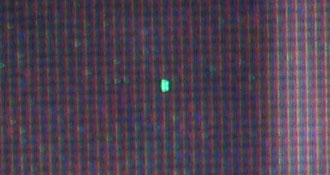
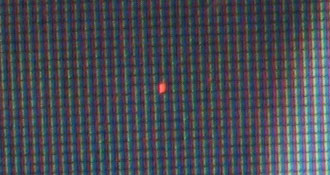
So even that, though unadvertised, seems to work better than my previous camera.
The S1, in many ways, is similar to my old S30: both cameras having the same resolution (image size), and the same basic settings and controls. While I would have enjoyed a better minimum shutter speed, 15 seconds (the same as the S30) is sufficient, and I was able to get the following shot (cropped and reduced) of Orion tonight:

 That’s Sirius in the lower left corner, by the way. I almost even got resolution on the Orion Nebula (the center “star” in Orion’s sword, see unreduced image at right), but that’s at minimum zoom–when I get my hands on a tripod another night, I’ll try a 10x zoom on it and see what develops.
That’s Sirius in the lower left corner, by the way. I almost even got resolution on the Orion Nebula (the center “star” in Orion’s sword, see unreduced image at right), but that’s at minimum zoom–when I get my hands on a tripod another night, I’ll try a 10x zoom on it and see what develops.
Unlike the S30, the S1 mysteriously lacks a focus assist light (the little lamp that comes on while focusing to help with low- or no-light focusing), a flaw many have noted; however, the S1 seems to focus OK in low light, you simply have to find an edge with enough contrast for the camera to lock the focus on. The S1 also has a slightly smaller LCD monitor–but it is on a very convenient swivel, making it easier to take photos from odd angles and still see what you are doing (it also allows you to turn the LCD screen inwards so as to protect it from being scratched while stored in a pocket or bag). With the S1, Canon fixed what I saw as a big flaw on the earlier Powershots: the “set” button used to be part of the 4-way toggle switch; in order to use it, you have to push the loose toggle switch exactly down, and not tilted to any side, for it to work properly, which is very hard to do. Now the “set” function has its own button, and is much easier to use.
This camera also has a lot of buttons on it: aside from the shutter/zoom toggle and the main setting wheel, there is a power on/off/play button/toggle, a separate button to start recording video, the four-way selection toggle, and ten other buttons–six on the back, two on the top left side, and two more on the lens base (if you don’t count the attachment ring release button, that is). One complaint I read was that it is hard not to accidentally press some of them in the normal handling of the camera. I don’t find that a difficulty, however; the normal areas for your fingers to go are button-free, so if you just hold it right, it shouldn’t be a problem.
The S1 does have a few weak spots, though. While 3.2 megapixels will do fine for me, they could’ve made it 4.0 at least, or so you’d think. The lack of an autofocus assist lamp is also a serious oversight (or maybe they had to make tough choices, I don’t know); and the lens cap is very poorly designed, is very loose-fitting and falls off at the slightest brush. I don’t even have to take it off, in fact: just turn on the camera, and the extending lens assembly gently slips it off. For now, I have it awkwardly tethered to one of the strap holders. But I got the lens adapter, which extends just beyond the maximum extension of the zoom lens, and plan to add a UV filter, to act as a sort of transparent lens cap, which should make the regular cap unnecessary.
One more down side, unavoidable really, is the form factor. The zoom lens does not allow for the camera to be slim enough to slide into your shirt pocket, which the S30/45 barely does. The S1 will fit on my jacket pocket, but only with the lens retracted; with the lens adapter, it might not fit so well. But I’m willing to live with that, and might even get a camera case, though I dislike them quite a bit.
I have noticed a strange artifact, that while locking the autofocus in direct sunlight, I sometimes get red vertical streaking on the LCD panel–but it disappears after taking the photo, and does not show up on the photo itself.
The camera’s video, aside from being zoomable, is now available as full-frame and full-speed, and will play just like footage shot with a digital video camera. The 1 GB Ultra II CF card I got ($85) is not only fast enough to record the video well, but also can take up to 11 minutes and 25 seconds of such footage (640 x 480 pixels, 30 fps). It’s a huge amount to download into the computer, but it could replace a digital video camera if you don’t film huge chunks of footage all at once. It saves the video in AVI format, so I’ll have to see if that can be imported into iMovie or not.
The S1 runs on 4 AA batteries, either Ni-MH rechargeables, or standard Alkaline batteries. That means you can easily buy extras in an emergency if your rechargeables run out, no proprietary battery packs holding you back, like the S30 has. My father gave me a set of four NI-MH’s with a fast charger unit, and I bought another 12 at Costco today (for about $25), so with four sets–each taking up to 500 or so images before quitting–I should never run out of juice again, with or without the backup.
One other personal drawback, I’m buying the camera in the U.S. to save about $150 on the purchase price, but Canon does not have a worldwide warranty like companies such as Apple have–which means if a defect shows up after I go back to Tokyo, I’ll have to eat the repair costs in Japan, or ship the camera back to the U.S., taking even longer and adding greater shipping costs. Hopefully, the camera will not need repairs, as my S30 has not–aside from those caused by dropping the poor thing on concrete a few times…
Overall, the camera is extremely satisfactory so far. More on its performance as I go. (And more photos, too!)

now with this new toy… can we have more japan photos?
I love your blog.
Greetings.
ey fellow S1 IS user
glad your enjoying your camera…although i do think you’re right about wishing it had 4.0 instead of 3.2mp.
play around with its manual control settings, you’d be surprise of the photos you’d get by tweaking the aperture and exposure controls.
Happy New Year! looking forward to more photos from your new camera.
glad your enjoying your camera…although i do think you’re right about wishing it had 4.0 instead of 3.2mp.Meh… not really so much. Sure, it’d be nice, but frankly 3.2 is just fine. It’s quite a bit larger than full-screen on my PowerBook, so cropping adds to the zoom if need be. And the increase of 0.8 mp is probably hardly noticeable–at that level, you need to add a couple mp just to really notice the size change in any important way. In another 3-4 years when I buy my next camera, they’ll probably have 12-15x zoom and 8mp or something. We’ll always be wowed by the new stuff. But the one I have right now is just fine for what I need.
so true…i said to myself it would take a year or two to replace my cam…exactly 8 months that’s how long it took
so now cruising for a dSLR…and the cycle continues 😉
so true…i said to myself it would take a year or two to replace my cam…exactly 8 months that’s how long it took
so now i’m cruising for a dSLR…and the cycle continues 😉